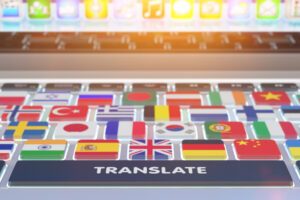Note: This blog post was originally written in Japanese for our Japanese website. We used our machine translation platform Translation Designer to translate it and post-edit the content in English. The original Japanese post can be found here.
Research on translation is progressing day by day, such as the development of neural networks and machine translation. Many people may not be familiar with translation studies, but it is an academic field related to various fields such as linguistics, sociology, and communication studies.
In this post, we will share one of the many translation theories, the Skopos theory.
What is Skopos theory?
Skopos means "purpose" in Greek.
The Skopos theory is one of the basic theories of translation developed in the late 1970s through the 1980s, and was mainly proposed by the German linguist and translation scholar Hans Vermeer.
This is the idea of translating according to the purpose of communication through that translation.
Purpose of translation?
Now, let's talk about the purpose, i.e. Skopos, of translation. Specifically, the purpose indicates what the translation will be used for, who the recipients (readers) will be, and when they need it by.
Professional translation companies like us ask the purpose of the translation work when we receive a request from our clients. We reflect that in the style guide and work instructions and provide them to our translators.

In general, IT and tech documents or legal documents are informational text and are intended to convey descriptive and accurate information.
On the other hand, literature, subtitles, and sometimes marketing documents tend to be text of expression, effectiveness, or audio media, having a wider range of purposes. This is because each situation has a different aim for the desired effect of translation depending on the content, medium, and expected readers.
For example, the same marketing document may have different purposes depending on whether it is for existing customers or potential customers. In addition, you would take into account other various purposes such as how you want readers to feel, understand, and take action.
Being aware of your translation purpose
The more specific the purpose of translation, the more likely that the purpose of communication will be fulfilled.
We humans use words skillfully. Even in daily conversations, we change our choice of words and expressions when talking to a young child, reporting to a boss, or talking with family members. This is because the purposes of communication are different. The process of translation work also involves a variety of people, and communication is important to achieve the work. For example, when we hear “red,” the color tones we imagine are not always the same.

When conveying information or messages to recipients using the same language, it is possible for the sender to convey the content directly in its own words.
However, for translations, the content is sent to the final recipient through multiple people while changing the language from the original text. Let's take a look at the table below that lists examples of translation services with different workflows.
| Examples of Translation Services | First Step | Second Step | Third Step |
| Translation and review | Translator | Reviewer | ― |
| Translation, review, and proofreading | Translator | Reviewer | Proofreader |
You can see that in these examples, translation work is performed by a team of 2 to 3 people. Moreover, translation companies like us or the client, who is the requester, take care of preparations and checks before and after the workflow.
Therefore, we believe that sharing the same understanding among all those involved in the translation work will help create better translations.
What is a translation policy?
Even if the original text is the same, if your purpose of translation is different, the translation policy will also change. A translation policy can include certain writing styles, words and expressions on different levels.
"This is an instruction manual for home appliances. It should be written in a clear and simple style."
"We want to send a newsletter to the existing customers that shows our personality. The expressions should be colloquial and friendly."
These are some of the examples of how to decide on your translation policy. It varies greatly depending on the purpose. With a different policy, you'll also give a different impression to the readers.
One of our translation services, machine translation with post-editing*, allows you to specify the criteria according to your request. As a result, we can offer a service that is faster and more low-cost than human translation and, at the same time, that satisfies the necessary quality.
*We edit and correct the machine translation output for this service.
Summary
In this post, we introduced the Skopos theory and the purpose of translation.
As we took time to prepare this post, it became an opportunity to reflect not only on the importance of the purpose of translation, but also on how to convey and listen. We would like to continue to create translations with our clients through better communication.
Kawamura's translation services
Kawamura International provides translations in a wide range of fields, including IT, software localization, medical devices, pharmaceuticals, tourism, manufacturing, finance, legal affairs, SAP-related documents, and all other general business documents. We assign the most suited translators according to your industry and specialty.
Kawamura also offers machine translation with post-editing services. Our strength is the ability to select the most suitable post editors from over 100 experienced post-editors. We can handle projects not only in English and Japanese, but also in Asian and European languages. We thoroughly discuss the target quality and work details before starting a project, and then propose a work plan according to your requests. Please feel free to reach out to us if you want to discuss any of the following options.
- How to translate faster at low-cost while maintaining quality
- How to get the best results within a limited budget
- How to translate a large number of documents quickly
_CMYK_OL.png)

